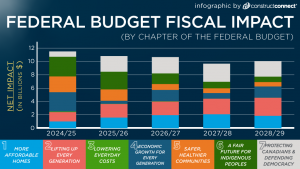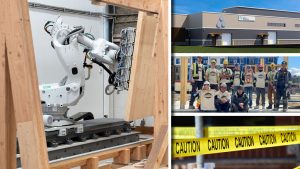OTTAWA—Many southern Ontario cities will see their real GDP growth ease from near, or above, three per cent in the last year to around two per cent or less in 2018, according to the Conference Board of Canada’s Metropolitan Outlook — Winter 2018.
The following are highlights about the major southern Ontario cities as reported in the outlook:
TORONTO
After expanding by more than three per cent annually for four straight years, Toronto’s real GDP growth will slow to a still healthy 2.4 per cent in 2018. The slowdown will be broad-based across many industries. Rising interest rates and the wider application of a mortgage stress test will cool the housing markets, limiting growth in construction and in finance, insurance, and real estate. Despite continued steady employment and income gains, retail trade activity is poised to cool as well, in line with rising interest rates and a slowing housing market.
As well, the manufacturing sector will remain stuck in low gear, despite a low Canadian dollar and healthy U.S. economy, held back by an improving but still modest business investment performance. Notwithstanding the slowing economy, employment will continue to advance, with a cumulative 116,000 net new jobs expected over 2018–19, following the creation of nearly 98,000 jobs in the two previous years.
OSHAWA
Oshawa’s real GDP growth is set to slow from a 15-year high of 4.1 per cent in 2017 to 2.4 per cent this year. Like Toronto, the slowdown will be also broad-based, with weaker gains anticipated in many industries including construction; finance, insurance, and real estate; and retail trade.
However, a few sectors will buck the trend and post stronger growth in 2018, including two locally important and closely linked industries — manufacturing, and transportation and warehousing. Employment should also bounce back this year after posting a rare decline in 2017.
GUELPH
Guelph, which makes its inaugural appearance in this edition of the Metropolitan Outlook, is forecast to post real GDP growth of 2.2 per cent in 2018, down from 3.6 per cent in 2017.
Manufacturing, construction, and wholesale and retail trade, among others, are expected to see slower growth this year. Despite the economic slowdown, Guelph’s employment is set to rise by a healthy 1.5 per cent in 2018, the fifth consecutive year of expansion. This will push down the unemployment rate from 5.4 per cent last year to 5.1 per cent this year, more than a full percentage point below the provincial average.
WINDSOR
Windsor’s economy is forecast to cool this year, with real GDP advancing by 2.1 per cent in 2018, following four straight years in which growth exceeded 3 per cent. U.S. light vehicle sales appeared to have reached a cyclical peak, signalling slower manufacturing growth. This will be the main headwind to the city’s economic growth, with rising interest rates playing a secondary role.
However, employment is expected to bounce back from last year’s 1.0 per cent decline, generating a total of 4,700 net new jobs over 2018–19. Still, the labour force is projected to grow at a faster pace this year, causing the unemployment rate to jump by almost a full percentage point to 6.5 per cent.
HAMILTON
After hitting a 17-year high of 3.4 per cent in 2017, real GDP growth in Hamilton is expected to moderate to a still decent 2.0 per cent in 2018. Cooler housing market activity this year will lead to slower growth in construction and in finance, insurance and real estate. Job growth reached a record high last year, but this will not be repeated in 2018, with employment expected to decline by 1.1 per cent in 2018.
KITCHENER-CAMBRIDGE-WATERLOO
Real GDP in Kitchener-Cambridge-Waterloo will grow by 1.9 per cent in 2018. The CMA’s construction industry is set to contract this year as work on the light-rail system comes to an end. Meanwhile, Kitchener’s services sector growth will throttle back this year, with moderating gains anticipated in the professional, scientific and technical services, which includes the city’s high-tech sector. Employment is expected to advance at a decent 1.1 per cent pace this year, allowing the unemployment rate to hold steady at 5.1 per cent.
LONDON
London is forecast to see real GDP growth moderate slightly from 2.0 per cent in 2017 to 1.8 per cent this year. The CMA’s manufacturing sector is anticipated to grow more slowly but continue to post solid gains as U.S. vehicle sales gradually cool from record highs.
Meanwhile, the city’s construction sector is similarly poised to make healthy gains, as new home construction is anticipated to hover comfortably around the annual average of the last 10 years. On the downside, lacklustre performances in several services industries, including wholesale and retail trade, finance, insurance, and real estate, and education, will serve as a key economic headwind. Job growth is forecast to pick up in 2018 following two disappointing years.
ST. CATHARINES-NIAGARA
St. Catharines-Niagara’s economy will remain on a slow but steady growth path, with real GDP expanding by 1.4 per cent this year. The local manufacturing sector will keep growing, bolstered by a low Canadian dollar and solid U.S. economy.
Decent activity in the non-residential sector will offset declining housing starts, allowing the construction sector to return to positive territory following two years of declines.
Meanwhile, the services sector will remain steady, with the retail trade, accommodation and food industries set to be the top performers, although output growth in each is forecast to moderate. Employment has declined for two straight years, but we believe a rebound is in the cards for 2018.











Recent Comments
comments for this post are closed